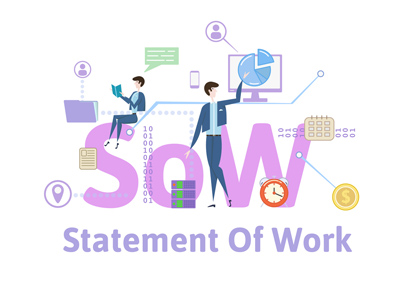A Statement of Work (SOW) is critical in project management and contracting. It outlines the specifics of a project, including the tasks, deliverables, timelines, and expectations. Here’s a closer look at what an SOW entails and why it’s essential.
An SOW is a formal document that defines the scope of work to be performed under a contract. It serves as a blueprint for the project, detailing every aspect of the work to be done. This includes:
- Objectives: The goals and outcomes the project aims to achieve.
- Tasks: Specific activities and responsibilities required to complete the project.
- Deliverables: Tangible or intangible products or services to be delivered.
- Timeline: The schedule for completing tasks and delivering outcomes.
- Standards: Quality and performance criteria that must be met.
- Acceptance Criteria: Conditions under which deliverables will be accepted.
- Payment Terms: How and when payments will be made.
Why is an SOW Important?
An SOW is crucial for several reasons:
- Clarity and Alignment: It ensures that all parties involved clearly understand the project’s scope and expectations. This alignment helps prevent misunderstandings and disputes.
- Accountability: By clearly defining roles and responsibilities, an SOW holds each party accountable for their part of the project.
- Performance Measurement: It provides a basis for measuring progress and performance against the defined objectives and deliverables.
- Risk Management: An SOW helps identify potential risks and outlines mitigation strategies, contributing to smoother project execution.
- Legal Protection: As a formal contract document, an SOW offers legal protection by clearly defining the terms and conditions agreed upon by all parties.
Key Components of an SOW
To create an effective SOW, include the following components:
- Introduction: Brief overview of the project and its purpose.
- Scope of Work: Detailed description of the work to be performed.
- Location of Work: Where the work will be performed, including any remote or on-site requirements.
- Period of Performance: Start and end dates of the project.
- Deliverables Schedule: Timeline for deliverables, including milestones.
- Applicable Standards: Any industry standards or regulations that must be adhered to.
- Acceptance Criteria: Specific conditions for the acceptance of deliverables.
- Special Requirements: Any unique requirements, such as security clearances or special equipment.
Tips for Writing an Effective SOW
- Be Specific: Avoid vague language. Clearly define all aspects of the project. Write in plain, straightforward language to ensure understanding.
- Include Visuals: Diagrams, charts, and tables can help clarify complex information.
- Review and Revise: Regularly review and update the SOW to reflect any changes in the project scope or requirements.
Conclusion
A well-crafted SOW is a cornerstone of successful project management. It provides a clear roadmap for the project, ensuring that all parties are aligned and accountable. By investing time in creating a detailed and precise SOW, you can set the stage for a smooth and successful project execution.
Expedience Software can help! Feel free to reach out if you have any questions or need further assistance with your SOW! Contact Us Today!






